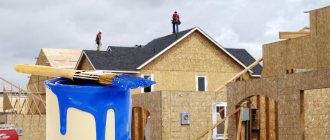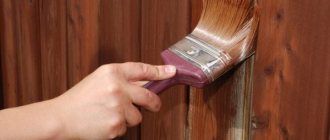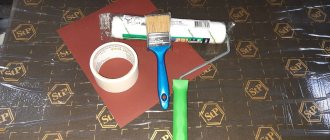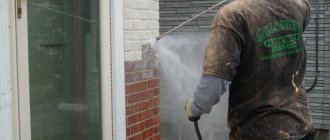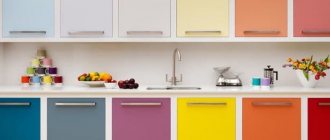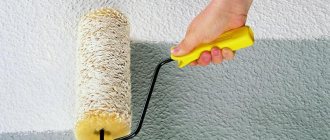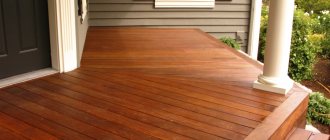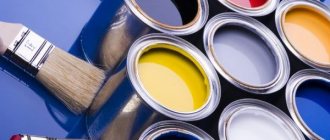24.03.2018 0
5098
OSB boards are increasingly used in construction work and furniture production. This versatile material is fracture-resistant enough to be used in residential flooring. The procedure requires knowledge of certain subtleties. In addition, not every workpiece is suitable for these purposes.
Types of OSB
OSB boards can be divided according to different criteria. This is the level of moisture resistance and strength, the presence of locking joints, the environmental friendliness of the material, and the thickness of the sheets.
There are several types of OSB. And not all of them are equally suitable for interior decoration.
According to their physical and technical characteristics, oriented strand boards are divided into four types. Each of them has its own purpose. Therefore, when purchasing building materials, it is necessary to take into account the conditions under which they will be used.
- OSB-1 does not have high strength and moisture resistance. Therefore, they are usually used as auxiliary material. Their cost is low, and they are often used, for example, to create temporary formwork. After dismantling it, it will not be a shame to dispose of the used parts.
- OSB-2 - characterized by fairly high strength, but not outstanding moisture resistance. As a construction material, they can only be used for interior work and exclusively in dry rooms. Suitable, for example, for covering light partitions in a room.
- OSB-3 are products that can be called universal. The boards are used both in dry rooms and in conditions of high humidity, including outdoors. They cover walls, form interfloor ceilings, and lay rough and “clean” floors for decorative coverings. They are often used as a material for continuous sheathing under some types of roofing coverings.
- OSB-4 - products with high moisture resistance and excellent strength. Therefore, they can be used in various fields of construction, including to create self-supporting loaded structures.
The slabs are most often produced in sizes 1250×2500 or 1220×2440 mm. Thickness range – from 6 to 25 mm. There may be other dimensions in length and width - this is worth paying attention to. Sometimes non-standard sizes allow you to choose the best option for a specific coverage area. That is, they make it possible to avoid a large amount of waste when cutting material.
OSB boards can be regular or tongue-and-groove.
Oriented strand boards are often produced with straight ends. But for finishing work, you can also look for tongue and groove ones.
- Conventional OSB sheets have smooth edges. When covering surfaces at joints with them, it is necessary to maintain a technological gap of 3–5 mm, which will keep the coating intact during thermal expansion of the material. Such slabs must be rigidly fixed to the base using self-tapping screws screwed in at intervals of 350÷400 mm. It is recommended to fasten large OSB sheets not only along the perimeter, but also additionally along the diagonals.
Tongue-and-groove OSB boards allow for a virtually seamless covering.
- Tongue-and-groove slabs are equipped with a tongue-and-groove joint. This option is more convenient when the slabs are planned to be used as a finishing coating, including for further painting. The joints are more accurate, and the gaps between the plates are practically invisible. When attaching tongue-and-groove OSB boards to a flat base, you do not have to use many screws. In addition, the products can be used for floating coating when installed on a concrete base.
Another important criterion for choosing OSB boards is the materials used in their manufacture. This parameter is especially important if the slabs are purchased for covering surfaces inside residential premises.
Formaldehyde resins can be used as a binder for wood chips, which release toxic fumes into the environment. Such materials have a formaldehyde emission class of E2 and higher, and are not suitable for internal use.
OSB boards produced according to European standards and marked “ECO” or “GREEN” are suitable for this application. The production technology excludes the presence of toxic compounds in the material. Wood raw materials are pre-treated with paraffin-wax impregnations, and polyurethane resins are used as a binder, which after polymerization become completely harmless to the environment.
The level of formaldehyde emission is indicated by the assigned class. E1 can be considered acceptable for residential premises, but E0.5 is better. And the best option is the already mentioned above “ECO” sign.
This option is fully suitable for residential premises. And it can be safely used for painting.
The certificate of conformity must indicate the formaldehyde emission class. For interior work, it should be no higher than 1, but better than E0.5 or “ECO”.
But in order to guarantee the “purity” of the material, when choosing it, you must carefully study the markings on the sheets. And this information must be confirmed by a certificate of quality (conformity), presented by the seller at the buyer’s request.
Slab painting
A material such as OSB can be painted with water-based or oil-based compositions applied with a brush, spray or roller.
The question often arises: is it possible to paint OSB boards with water-based compounds? It is possible, but this will increase the shape of the sheet slightly (swelling is possible), so it is highly advisable to use OSB 3. If you paint only on one side, this may lead to a slight bending of the panel. Therefore, it is worth treating the slab with water-based paints in cases where the appearance is not important. In opposite situations, it is necessary to use oil compounds. What are the features?
1. Any paint tends to spread on sharp corners . Therefore, before painting, they must be rounded by light sanding (with a radius of at least 3 mm). This is especially important for OSB used for exterior finishing.
Before painting OSB, the perimeter is first painted
When treating slabs located outside, it is necessary to use paints intended for outdoor use. In this case, you should follow the manufacturer's recommendations for painting wooden surfaces.
2. Edges. Their surface is more porous than the plane of the slab. The result is greater absorption, i.e. moisture absorption. Therefore, special attention should be paid to sealing edges. Moreover, this operation must be carried out before priming and applying the main coating.
Painted OSB floor
3. Priming . If you decide to treat the slabs with an antiseptic or fire-retardant impregnation, then you should carefully read the instructions - some of these chemicals may contain a high alkali content, which will require the use of a special primer.
4. Layers of paint . The opinion that the thicker the layer, the better it will protect the surface, is not entirely true. It is better to apply several thin coats rather than one thick one. In this case, each layer must be thoroughly dried.
All recommendations for painting slabs when used outdoors can be formulated as follows:
- the edges must be processed before the assembly of the structure begins (rounded and sealed);
- If water-based sealing compounds are used, then due to swelling in the future, mandatory grinding will be required. Therefore, it is better to use solvent-based formulations (for initial processing);
- when using transparent dyes, it is necessary to use those that prevent the penetration of ultraviolet rays (i.e., inhibitors must be present in the composition of such materials);
- slabs must be fastened in such a way that there are no potential areas for moisture accumulation;
- It is necessary to cover both sides with dye equally;
- A 45 degree end connection is not recommended (due to the formation of sharp edges). If the finishing requires that the edges will be visible after completion of the work, then they must be filled with cellulose (wood) filler, then sanded and primed.
Briefly about the material
Oriented strand board (OSB) consists of 90% natural wood in the form of large chips.
Crushed wood chips are joined together by gluing with different types of resins, polymers and adhesives. The result is a dense and hard material. But, as you know, natural wood is afraid of moisture and can swell under its influence. To protect the boards, they are impregnated with various chemical impregnations. The marking of the slabs depends on the type of impregnation used. Surely you noticed that the abbreviation OSB also has a number in the name. What does it mean?
- OSB-1 – has a minimum level of moisture-proof impregnations in its composition, therefore it is suitable for use only in dry, heated rooms.
- OSB-1 can withstand only short-term and minor exposure to moisture;
- OSB-2 – intended for finishing indoors with an average level of humidity;
- OSB-3 – able to withstand high levels of humidity, and even short-term wetness;
- OSB-4 is the most moisture-resistant category of material. Recommended for outdoor use.
Description and properties of OSB boards
OSB is a transliteration of the English term OSB. In Russian, the abbreviation correctly sounds like OSB - oriented strand board. In terms of filling, it is similar to chipboard. However, you will not cover the floor with chipboards - it is not practical. But OSB is perfect for this.
In its production, wood chips or large shavings are used. The filler is laid in layers. Moreover, each of them is located at an angle of 90° to its neighbors. Even layers of wood chips are located across the board, odd layers are located along them. Thanks to this, strength is achieved, which allows OSB to withstand loads even on an uneven floor. The material has several categories that differ in criteria:
- chip size;
- board thickness;
- quality of binder resins (moisture resistance level).
OSB board
Product classes:
- OSB-1. Thin board with a minimum level of moisture resistance. Used for internal cladding of walls and ceilings in rooms with low humidity. The cheapest type of OSB.
- OSB-2. It has greater strength and low hygroscopicity. Typically used for making furniture.
- OSB-3. Has an optimal level of moisture resistance. Convenient for interior and exterior decoration. If the thickness is sufficient, such OSB can be laid on the floor.
- OSB-4. The strongest among analogues. Has the highest level of moisture resistance. It is used to make exterior panels for building houses.
Advice. Experts recommend using OSB-3. Manufacturers produce special floor slabs with a tongue-and-groove system.
Phenol-formaldehyde is often used as a resinous impregnation of OSB. In Europe, these substances are considered harmful to health. They can only be used for external work. A safe alternative is polyurethane resins, but such a board is more expensive.
How to care for painted slabs so they last a long time
Painted OSB board requires special care:
- wash the surface with soapy water at least once every six months;
- Renew paint every 10 years to prevent cracks, chips, and fading. It is enough to dilute it to a translucent shade;
- do not use household chemicals to care for the painted surface, unless otherwise permitted by the paint manufacturer;
- do not expose the coating to thermal influences (it is not advisable to place heating equipment - radiators, electric heaters, fireplaces - next to the painted OSB board);
- Avoid impacts, scratches and other external influences.
Important: you can repaint the slab more than once. But you should not change the color earlier than 6 months after application.
Before updating, you don’t have to remove the old coloring pigment from OSB, but be sure to sand the surface and prime it (treat it with varnish, drying oil, if desired).
Plastering OSB boards
Very often, OSB boards are in demand in the construction of frame houses - they are used to upholster the load-bearing frame. One of the ways to protect it in this case is plastering. However, here again the problem of absorption arises and the question “is it possible to plaster OSB” is quite appropriate.
The process of plastering slabs has its own characteristics. These, first of all, include preliminary fastening of bituminized cardboard to the surface. It is also possible to use roofing felt with a paper base or facing kraft paper.
The mesh on the OSB wall allows the putty to stick
The next stage is attaching the galvanized plaster mesh. The resulting structure is filled with a special adhesive (the grille must be completely immersed in it). No special plaster on OSB board is required. The only requirement is that it must be vapor-permeable and polymer-acrylic.
Series of preparatory work
Before painting the outside of OSB boards, you should perform basic preparatory operations. To do this, it is necessary to clean the panels from construction dust,, if necessary, level and seal assembly seams, and also prime the material.
Now about everything in more detail:
Sealing the installation seams ensures the integrity of the façade and protects the material from environmental influences. Before sealing the seams, it is advisable to round off all sharp edges of the OSB boards (with a radius of 3 - 4 mm) using a file. And the work itself should be carried out using putty solutions for external use.
In addition, the end sections of the OSB should be sealed. After all, these are the places that are most vulnerable to moisture penetration. For these purposes, you can use a silicone or acrylic-based sealant for exterior use. However, it should be understood that if the sealing areas are subsequently painted, then silicone sealant cannot be used (paint will not adhere to it).
- Leveling OSB involves eliminating defects such as drops, chips, and potholes. It is more justified to carry out the presented operations using putties for external work, which should be cleaned after application and drying. The sanding procedure can also be used to remove drops and protrusions.
- Priming the material performs several functions at once: it improves the adhesion of paintwork, reduces paint consumption and provides protection against rotting and fungus formation (in the case of using antiseptic primers). OSB can be primed for subsequent painting by using deep penetration primers, acrylic-based varnishes, or a homemade composition based on PVA glue. You can read about how to make such a primer in this material.
How to paint a subfloor
After laying the OSB, it’s time to ask the question: how to paint them? The sheets should first be treated with a deep penetration primer. This will create an airtight protective layer. To consolidate the effect, after 12-14 hours you can apply another layer of paint.
Next, experienced builders advise leveling the flooring, hiding the joints, fastener heads and other elements. Do not cover the joints with silicone. Use acrylic putty or a dispersion type equivalent. After drying, rub and apply another coat.
Choose a paint that is compatible with primer, suitable for interior use, and is resistant to mechanical damage. Painting is done in two layers with a break for drying. Irregularities in the first layer of paint are sanded down. OSB floors are not afraid of cold, dampness, rodents, or mold. The material is slightly deformed. With its help, you can level out unevenness that exists on the floor surface.
The correct choice of material is no less important than its installation. Experts warn that there are many uncertified or low-quality products on the market. Instead of European OSB, they can sell Chinese OSB, which cannot be used for floor finishing. Be sure to ask the seller for documents for the goods.
Features of painting wood boards
When thinking about how to paint OSB panels, you must remember that the material consists of 90% wood . Therefore, most paints intended for woodwork are suitable for painting. However, OSB boards have several features:
- Low adhesive ability. Some compounds do not adhere well to slabs. This is due to the presence of binding components in the panels. Resins do not absorb coloring enamel well.
- Texture of the coating. The surface of the building material is rough and uneven. This feature requires more thorough preparation of the base - grinding is required. In addition, pronounced texture increases paint consumption.
- Age of the slab. The older the OSB sheet, the worse the paint adheres to it. The surface quality of used slabs deteriorates over time, especially if the material has been outdoors. Therefore, it is better not to delay painting and do it immediately after installing the OSB.
For painting, it is better to use polymer-based paints, and it is better to avoid compositions with a water-soluble base - they protect wood boards from moisture less well.
Why do you need to paint OSB?
OSB painting is used for:
- creating a stable dense film on the surface of the material, protecting it from the destructive effects of high humidity and ultraviolet radiation;
- leveling the working surface, which after painting becomes absolutely smooth;
- decoration - often coloring is used to create original decor and shade.
What are the benefits of painting OSB boards?
With their help, you can quickly and cheaply sheathe the outside of your house. After installing OSB boards, you need to refine the surface. Painting is one of the simplest and most affordable methods of decorative finishing. In addition, there are some other advantages:
- the paint protects the slab from moisture, so the slab does not deform;
- Using paints we decorate the unsightly appearance.
How to coat OSB board with varnish
Today, during the construction or renovation of house buildings, plasterboard is replaced with plywood sheets - oriented strand boards OSB (abbreviation OSB). Construction of houses using frame technology, indoor partitions, installation of floors - this is not the entire list of slab applications.
When panels leave the factory, they are covered with a protective layer from moisture, UV rays of the sun, and the effects of chemical compounds, preventing the appearance of mold and mildew. But after installation, the slabs do not look aesthetically pleasing. Therefore they are painted or varnished.
Varnish for OSB boards is a material that is available to the average buyer and provides a beautiful and durable protective covering layer.
What paint compositions are used for OSB boards?
Variety of paints and varnishes suitable for OSB
To paint wood and products made from it, as a rule, several types of protective and coloring compositions are used:
A variety of paint and varnish compositions can be used to paint OSB surfaces.
- Acrylic paints are dispersed, made on the basis of polyacrylates and their copolymers, which act as film formers. When hardened, they form a fairly strong polymer layer on the surface of a wooden slab. This type is used for painting both internal and external surfaces. These are environmentally friendly compounds, they protect wood from moisture and have an affordable price.
- Polyurethane paints also create a protective and decorative layer on the slab. This composition is used mainly for interior construction and finishing work.
- Latex paint is highly elastic and resistant to detergents. These compounds are non-toxic and are excellent for painting interior surfaces.
- Alkyd paint compositions are produced on the basis of alkyd resins. The film formed on the surface of OSB has higher strength, in contrast to aqueous solutions. Alkyd paints do not contain toxic substances, they can effectively protect the material from moisture and ultraviolet rays, are resistant to fading and dry quickly after application. When painting, the paint emits a strong odor, so the room should be ventilated.
- Oil paints have a thick consistency, so they form a noticeably thick layer on the surface. They are great for applying to the end faces of slabs, as they can protect them from moisture absorption. Paints have a specific odor that takes a long time to dissipate after application. In addition, oil paint, unlike those mentioned above, requires a longer drying time.
Primer paint designed specifically for application to OSB boards
In addition to universal paints for all types of wood, there are compositions specifically designed for painting OSB. They are usually called primer paint and have the following features:
- They are able to create reliable protection for oriented strand boards from external influences of moisture and ultraviolet radiation.
- The composition has excellent adhesion properties to the surface of such plates.
- High elasticity and vapor permeability are noted.
- The density of the layer prevents the natural color of the OSB from showing through.
- Primer paint is produced in a basic white color and can be tinted to the desired shade.
- Primer paint is an environmentally friendly composition. It is made on a water basis with the addition of a special acrylic polymer, mineral fillers and antiseptic additives.
The primer can be used as a base coating, or to prepare the surface for the subsequent application of a decorative layer.
Criteria for choosing paint for interior work
When choosing a composition for painting OSB indoors, you need to consider some factors:
- The type of wood chips and type of binders used in the production of strand board.
- Decorating method, that is, it is planned to preserve the structure of the surface of the slab, or to make it smoother.
- Area of application (floors or walls).
- Features of the room in which installation will be carried out.
Paint should be selected based on the following recommendations:
Universal oil paint "Coloray".
- Considering that OSB boards consist of 90% wood raw materials, oil paint will be a universal coating for them. Such compositions of the trademarks “Coloray”, “Syntilor” and others are distinguished by high quality. They have excellent adhesion, minimal absorbency, and the base on which the paints are made (drying oil) significantly reduces material consumption. Oil paint forms a reliable, durable protective layer on the surface, so it is well suited for painting OSB boards laid on floors.
Alkyd semi-matte enamel "TEX"
- Alkyd enamels are well suited for painting both walls and floors. They also create a durable, reliable coating. However, the consumption of this type of coloring composition exceeds that of oil-based ones.
Water-based wall paint “Sadolin”, resistant to wet cleaning
- Water-based paints are not very resistant to moisture. They are well suited for painting walls in dry rooms. These are environmentally friendly compositions, so they are used to decorate the walls of residential premises - children's rooms and bedrooms. The brands “Tikkurila”, “Teknos”, “Sadolin”, etc. are considered one of the best on the Russian market. By the way, some of the compositions are still resistant to regular wet cleaning.
Polyurethane paint provides a coating of increased wear resistance
- For finishing OSB surfaces, especially if they cover rooms with high humidity, polyurethane paint made from organic solvents is well suited. Traditionally, similar paints from the brands “International Paint”, “Sterling” and “Coatings” are distinguished by their high quality. When polyurethane compounds are applied to OSB, they create, in combination with the resins contained in the material, high-strength compounds, which makes the coating durable and wear-resistant.
Many people like the natural color of wood. They can be advised to use transparent or translucent water-based varnishes.
- If you plan to preserve the original structural pattern of OSB, as well as improve the quality of the surface, the walls are coated with water-based transparent varnishes.
Two-component transparent composition for self-leveling floors.
- If OSB is planned to be laid as a finishing material on floors, and it is necessary to achieve a smooth surface, an epoxy composition can be used for the coating.
Coating the OSB floor surface with a self-leveling epoxy compound.
The surface can be decorated by giving the composition the desired color or by adding certain inclusions (glitter, chips, etc.) to it. Or they preserve the natural color and pattern of the slabs. And the epoxy composition is applied using the technology used to create a self-leveling polymer 3D floor.
Self-leveling polymer floors - a bold solution in interior decoration
The decorative nature of such coverings is not limited at all - it all depends on the imagination of the owners. Self-leveling floors are often built on a concrete base, but a well-prepared, stable OSB surface will also be a good base for them. And how the pouring is carried out - read in the special article on our portal “Do-it-yourself 3D floors” .
How to paint an OSB board inside a house
When painting OSB boards indoors, it is important to select a non-toxic composition, and also take into account the specific use of the surface being painted.
Possible options:
- acrylic paint;
- stain and varnish;
- glaze azure.
Acrylic paint is considered the best option for interior work . Contains water and acrylates. After application to the surface, the moisture from the paint evaporates, and a protective polymer layer is formed on the OSB board.
Useful: Windows in a frame house: installation features
Pros of acrylic paint:
- good adhesion and wear resistance;
- color variety;
- vapor permeability;
- UV resistance, color retention;
- protection of wood boards from damage;
- affordable price.
Acrylic paint can be used to paint the walls and floors of a room. After OSB treatment, the boards acquire a uniform tone.
Combining stain and varnish allows you to preserve the OSB pattern . This method is often used to make the coating original. First, a stain with a patina effect is applied, and then covered with polyurethane or vinyl varnish.
Glazing azure allows you to emphasize the OSB pattern and make the coating wear-resistant. For interior work, flowing acrylic compounds are used. Glaze strengthens the surface and gives the coating a rich shade.
Features of the material influencing the choice of paint
OSB boards can be called a specific material due to the pronounced texture of individual chips on the surface and some other features.
Before you start choosing a particular type of paint, consider the following points:
- Without preliminary surface treatment, the paint may adhere poorly or unevenly to the base. This occurs due to poor adhesion or because the slabs are treated with special impregnations, which in turn form a film on the surface;
- It is not recommended to choose water-based compositions due to the fact that excess moisture can lead to swelling of the surface;
- A rough surface will require more paint;
- If the slabs are poorly painted even after careful preparation, it means they were stored incorrectly. Material that has been lying outside for more than one year must be thoroughly cleaned of dust and other contaminants, sanded and treated with antiseptics;
- At the ends, the slabs have a more porous structure; accordingly, they will require more paint to fill the voids. To avoid excessive consumption, it is recommended to pre-treat the seams.
Priming Features
Before putting putty on OSB panels, they must be treated with a suitable primer. Moreover, the slabs should already be carefully polished before that period. In this form they can be purchased on the modern construction market. Otherwise, you will have to spend a lot of additional time preparing the material.
As a primer, it is important to use only the composition that was originally created for finishing wooden bases. Usually this product does not contain water at all. It is often made from drying oil.
Important! The end parts of building materials suffer the most from moisture. They should be thoroughly treated with primer before installing the panels, since this will then be impossible to do.
Priming of OSB boards is carried out only with those products that do not contain water at all. Source obustroeno.club
How to attach sheets?
With your own hands you can assemble not only the sheathing that will serve as the base, but also install the OSB panels themselves. There's nothing complicated about it. You will need to screw the plates using regular self-tapping screws. In this case, it will be necessary to leave small gaps between them, which will be at least 3 mm. These gaps will help in the future to avoid possible deformation of multilayer slabs due to their expansion. Such processes occur if the cladding material is affected by changes in the humidity level inside the room.
When the slabs are completely installed on the sheathing, they can be safely coated with high-quality varnish. Some owners prefer to tint OSB boards or supplement them with other finishing materials - there are a lot of options.
How to paint OSB
Preparatory work
Before painting, the slabs must be prepared. This is necessary so that the paint adheres well and sticks to the surface.
If you plan to cover the walls and ceiling with strand boards, then it is easier to carry out the preparatory work even before installing the boards on the sheathing.
Depending on the chosen painting technique, it may be more profitable to do it in advance, before installing the sheathing. This is due to the fact that some of the decorating methods involve several stages of cleaning and painting.
- So, the first step is to clean the entire surface using a hand-held sanding machine, onto which a sandpaper attachment is attached.
Cleaning the OSB surface from the protective layer.
If you plan to preserve the textured pattern of the OSB, then an sanding attachment with a medium-sized grain (approximately P120) is selected for sanding to free the surface from the protective layer of binders. If the slab needs to be leveled to smoothness for continuous painting, then the cleaning is carried out first with coarse grains (P80), and then with fine grains (P200 and higher).
After removing the top protective layer, the primer or paint will easily penetrate into the structure of the material.
If OSB-3 or OSB-4 boards are purchased, then their cleaning should be carried out most carefully, since they have a more reliable varnish coating on the surface.
The screw caps must be recessed into the wood by 1÷2 mm. The seams between the laid sheets are puttied.
- The second step in preparing the slabs is to mask the seams and screw heads. Various means are used. This, for example? It can be ready-made parquet on an oil-adhesive basis or a special elastic putty. A sealant or special elastic tape is used.
Elastic putty for joints between OSB boards.
If the joints and holes from the screws need to be completely hidden, preserving the natural color or making it several tones darker, then sawdust should be added to the putty, which will remain when cutting the sheets. In this case, the gaps must be filled very carefully, without going beyond them. And if necessary, after the putty mass has hardened, the seams are cleaned with a grinding machine with an emery attachment.
Durable and airtight “RAPID CELL” tape for sealing seams between OSB boards.
If the surface should be smooth and uniformly colored, then elastic tape is used to mask the seams.
- The next step is to apply a primer to the slabs under a solid monochromatic painting, which can be polyurethane-acrylic, acrylic or alkyd varnish. The choice of composition depends on the paint base that will cover the surface. When using water-based varnish as a primer, it must be diluted in a ratio of 1:10 with water.
Priming the surface with diluted varnish
When choosing an alkyd varnish, “White spirit” is used as a thinner.
Besides these options? For preparatory work, adhesive primers are used, for example “Aqua Filler”. This type of primer is designed to isolate wood from paintwork. Such compositions are especially suitable for coating slabs made from coniferous wood, since the primer will prevent the resin from bleeding onto their surface.
The sequence of preparatory work for decorative painting using primer paint.
In addition to the primers listed above, a special primer-paint can also be used to pre-prepare OSB for painting.
OSB painting
So, OSB boards can be painted in one color, maintaining the texture or leveling the surface to smoothness. This type of painting is not difficult to do - it is not particularly different from the usual application of paint on any other base.
When painting large areas, it is most convenient to use a paint roller
The painting process will go quickly if you prepare the slabs correctly. However, there are other techniques that can change the slabs beyond recognition, reliably hiding the joints and fasteners.
Agree, the painted surface does not look very presentable
This is what the slab will look like if you simply apply paint to it with a roller or brush. This option is unlikely to be suitable for residential premises. Therefore, some home craftsmen and professional finishers are developing and putting into practice more creative options for painting OSB boards.
There are several available options available.
The first option for decorating OSB
In this case, the floors are finished using multi-layer painting technology. Achieving this effect will require a lot of time and patience.
To paint the floor, you need to prepare several tones of the same color. The work occurs in the following order.
Option for painting OSB floors - imitation stone surface
- The first thing we recommend doing is drawing up a sketch of the future floor design. Moreover, it is advisable to execute it in two versions - graphic and color. The sketch will clearly show what the finished coating will look like and will also help in further work.
- The slab is completely painted with primer paint of the base color. The lightest shade of the selected color should serve as the base. To apply paint you must use a spray gun. This application will ensure that the paint gets into all the recesses of the textured surface, while maintaining the surface relief.
- To emphasize the depth of the relief, the floors can be lightly sanded with a sander.
- Now the entire painted surface is divided into fragments shaped like stones or other elements. The marking is carried out based on the drawn up sketch, first with a simple pencil. And then it is “raised” with a brush and paint 4-5 tones darker than the base color.
- The next step is to paint each fragment of the coating with paint of a different tone, which must be prepared in advance.
- Next, each of the fragments is cleaned. At this stage, it is not necessary to process the entire surface; you can clean one or two sides of the stone, simulating its volume.
- Then the contours of each of the stones are drawn again.
- After drying, the surface is coated with varnish, the base of which is selected depending on the type of paint.
This coloring option is only available to a creative person who knows how to work with paints.
Second option for decorating OSB
If you don’t want to come up with the shape and size of the stones, you can go another way. Specifically, lay out a covering of small square slabs. Adjacent panels are laid so that the direction of the laid chips is perpendicular to each other.
Mosaic laying of square slabs in a checkerboard pattern will somewhat “revive” the floor surface
This option will allow you to create an original textured pattern of the floor covering and well disguise the joints between the slabs.
If the OSB has a color that satisfies the home owner, then the coating can simply be coated in several layers with varnish or epoxy, having previously cleaned the surface. If the shade is not completely satisfactory, it can be changed using stain or the technique suggested below.
However, it must be taken into account that the slabs will have to be cut into separate fragments, the edges of which must be perfectly smooth. In addition, this type of flooring will look aesthetically pleasing only on a perfectly flat base.
The third option for decorative painting of OSB
This method of painting slabs is accessible to anyone, even an inexperienced craftsman. The main thing in this process is to follow the instructions provided by the professionals.
Some try to achieve this or a similar effect on the walls using decorative plasters. But it turns out that a surface made of OSB sheets, paint and a little effort is quite enough.
The photo shows an example of painting OSB, which is used to cover the walls inside the house. In this case, two colors of paint were used for decoration. But if desired, more of them can be used, depending on the desired result.
How the process of decorating OSB is carried out using this technique will be presented using the example of small sections of slab in the instruction table.
To work in this case, the tools used were a Kremlin HTI spray gun with a 1.8 mm nozzle, a sanding machine with sanding attachments having grains of different sizes, and a special sponge with an abrasive surface.
| Illustration | Brief description of the operation performed |
| So, the first step is sanding the surface. A grinding machine with an emery attachment with P180 grain installed on it is used. The process is carried out without strong pressure, since only the protective layer needs to be removed from the stove. | |
| Since paraffin or wax, as well as resins, are used in the manufacture of OSB, the surface of the board must be coated with a barrier primer. It will delay the penetration of resins and paraffin on the decorated floor covering. In this case, barrier soil FI M 194 is used. Soil consumption will be 50÷60 grams per 1 m². The primer is applied using a spray gun. The drying time for this layer is one and a half hours. | |
| The next step is to apply a pigment primer to the entire surface of the slabs, which will become the basis for creating the color scheme of the finishing material. In this case, white polyurethane primer is used. The consumption of pigment primer will be 90÷100 grams per 1 m². The time required for the coating to dry under normal conditions is 3÷4 hours. | |
| When the soil is completely dry, the part must be sanded again using sandpaper with a grain size of P320 on the sanding machine. After sanding, the surface must be thoroughly cleaned of dust using a vacuum cleaner. | |
| To create the effect of a delicate shine, the next step is to apply the “Mother of Pearl Effect” composition to the surface. The consumption of the wet applied layer will be 100÷120 grams per 1 m². And then 40÷60 minutes are given for the composition to dry. | |
| Patina paint is sprayed on top of the mother-of-pearl layer, also using a spray gun, which will give the effect of “noble aging.” The consumption of this composition is 60-80 grams per 1 m². | |
| 5-7 minutes after spraying the patina, its excess must be removed with an emery sponge (block) with P320 grain. Then the entire surface must be thoroughly cleaned of dust with a vacuum cleaner. | |
| This photo shows the result of the work done. He is already quite capable of becoming the final option. But if you wish, you can continue decorating. | |
| The next step is to spray tinted acrylic varnish mixed with stain over the slab. Instead of stain, another painting composition can be used. The main thing is to take into account that the composition of all the solutions used for coloring were organically combined with each other. In this case, a zero-gloss varnish was used. Its consumption will be 80÷100 grams per 1 m². This layer should dry for one and a half hours. | |
| As the varnish coat dries, the color may change slightly, and its dullness will increase. This factor must be taken into account when composing the shade of stain or paint. | |
| The finishing coating can be matte, glossy or soft touch. “Soft-touch” literally translates as “soft to the touch.” This is a special rubber-like elastic matte paint coating. This option is perfect for wall surfaces. |
When choosing this coloring technique, great opportunities for creativity open up. It’s quite possible to come up with your own options that will please the eye.
* * * * * * *
As can be seen in the examples shown, in any case, the specific surface structure of oriented strand boards can be “played up” for the benefit of the overall decorative effect of the coating. That is, painting OSB may well be considered a full-fledged finishing technology.
At the end of the publication, there is a video that demonstrates another easy-to-do-it-yourself method of original painting of an OSB surface.
Video: Original method of painting OSB
Recommendations for choosing the right composition
To correctly decide what to paint OSB with, you need to take into account the type of binder of the slab, the expected loads on the surface, and also decide on the decoration method.
General tips to help you make a choice:
- For children's rooms and bedrooms, it is better to use water-based paints - they are environmentally friendly and safe for health.
- In rooms with high humidity, polyurethane compounds based on organic solvents should be used. In combination with resins, such paints create a durable, wear-resistant, washable coating.
- Self-leveling epoxy compounds are suitable for treating the floor and creating a smooth surface
- Alkyd enamels are suitable for painting walls and floors - the paint forms a durable, wear-resistant coating.
Recommendations for puttying OSB
Puttying work is carried out exclusively in warm conditions, with air humidity not exceeding 60% . When applying the composition to the ceiling, four layers must be completed. They will allow you to mask the fiberglass mesh and level the surface layer.
Tools and materials
To process an OSB board, you need to have on hand sandpaper, a rubber spatula, a trowel, a roller, a container for mixing the composition (if necessary), a drill with a mixer attachment, and a sickle to reinforce the joints.
Preparing the walls
Before puttying OSB boards, it is necessary to treat the working area with a primer. This way the wood surface will reliably adhere to the putty mixture. This will also prevent substances that fill the wood (for example, essential oils) from bleeding through. After priming, you must wait 3-12 hours until it dries completely .
Applying putty
OSB putty for interior work is applied to the surface to be treated, leveling with a wide spatula using smooth arc-shaped movements. The starting coating allows you to fill all the recesses and defects. The formation of streaks during work should be avoided . After the first layer has dried, you need to sand the coating with abrasive paper.
How to create a patina effect?
Patination is a decorative technique that allows you to “age” a product. The patina looks beautiful and unusual. The patination process includes the following steps:
- Apply one or several layers of stain, previously diluted with acetone, to the surface. It can be diluted with water, but it does not evaporate so quickly, which significantly delays the work.
- Prime the treated oriented strand sheet.
- Apply a layer of patina to the work surface.
- Wipe the product with a dry sponge. This allows you to remove the patina from the protruding elements of the work surface and leave the paint only in its recesses.
- Varnish in several layers so that the decorated area does not change color and is not damaged by external factors.
